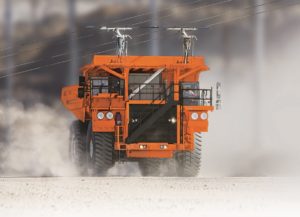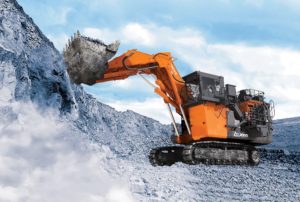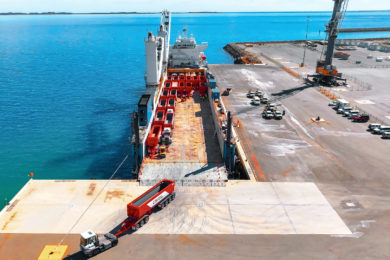Paul Moore sat down with Hitachi Construction Machinery at MINExpo 2021 earlier this year to talk everything from the electric transition to open autonomy. Interviewed were Brian Wells, Division Sales Manager, Hitachi Construction & Mining Division and John Schellenberg, Mining Product Manager, Trucks – Global Mining Group
Q Everyone seems to have their own slightly different take on helping mining customers get to zero emissions. What is Hitachi’s way forward?
BW: At Hitachi we are talking to customers about mining fleet decarbonisation on two fronts – what can the company do for mines to mitigate emissions today and what can we do to achieve future 2025-2030 and final 2050 targets. Already today from Hitachi you can make choices to significantly reduce your carbon footprint – part of that is trolley truck technology on the mining truck side, then on the mining excavator side we have a complete electrically powered line-up. Looking in the medium term then you have options like trolley trucks with onboard batteries.
Brian Wells, Division Sales Manager, Hitachi Construction & Mining Division

JS: If you used electric excavators with a trolley truck fleet today – you can reduce emissions by up to 30% or more versus conventional diesel trucks and excavators. Yes those excavators are likely to remain cable tethered, but this relates more to the fact that they are very energy intense with the engines running typically an 80% duty cycle versus a haul truck that might have a 35% duty cycle – both using similar sized engines. So you are relatively speaking burning a lot more fuel on the excavator, meaning it would be difficult today to find a battery to keep up.
Q So on the excavators have you or are you seeing a big uptick in orders for or interest in the electric models?
BW: Over the last nine months, electric shovel interest has increased significantly but I would say a lot of the major emissions reduction conversations in recent months have been around next generation truck development. Many customers start with wanting a battery truck as soon as possible but we are helping them understand the steps that will get them there in terms of technology stages but also as mentioned helping them achieve emissions reductions from the outset.
JS: We’ve been making electric excavators for over 25 years. Typically, we have sold these to markets like the former CIS and countries including Russia and Kazakhstan where diesel fuel costs are higher but there is access to cheaper power such as hydropower. Also, they are used to working with cables and some larger mines also work with electric rail haulage for ore. Interestingly, in some markets like Eastern Canada, up until now there has been some reluctance to switch to electric shovel despite having lower cost power – though this is now changing quickly as targets are being put in place. In Western Canada, some of the oil sands operations can generate cheap power as a byproduct from steam being produced in cogeneration plants for SAGD operations – that power needs to be used more in their conventional mining operations. I would say many customers have shown reluctance as they are used to the diesel system – diesel transport in bulk, storing it at the minesite at fuel depots, monitoring diesel usage. I have regularly had discussions with mines who know the price of diesel but not the price of electricity. Now we have to get customers just as confident with electrical infrastructure at mines such as how to manage substations, cabling and all the rest of it.
John Schellenberg, Mining Product Manager, Trucks – Global Mining Group
 Q How can mines get remaining years of life out of diesel shovels? Does the electric retrofit question get asked? On both trucks and excavators, how are you already helping customers in the electric transition?
Q How can mines get remaining years of life out of diesel shovels? Does the electric retrofit question get asked? On both trucks and excavators, how are you already helping customers in the electric transition?
JS: Our excavators are very modular as we remove the engines this way during rebuilds. So, it is technically possible to convert them to cable power. Whether that is commercially the right decision is another question – it may be better to sell the diesel unit and opt for a new electric machine.
BW: There’s been a lot more interest in electric trucks and we are already working with some customers on potential projects. They mainly want to electrify existing operations today – but again, there are expectations that they can just get an electric truck – we then ask who is going to supply the power, how are you going to set up the infrastructure based on the existing haul routes, who will build the trolley lines etc. We can help with all of this through our partnership with ABB for example, or we can help just with parts of it, but we need to know how they want to progress. This is a big part of the electric transition challenge – helping mines navigate towards a true electric mine infrastructure. It is further complicated by the number of equipment and technology companies that are coming up with solutions – it includes OEMs like ourselves, electric drive suppliers, power companies and engine suppliers but also others.
Q In trolley trucks you already have a leading position with fleets at mines like Kansanshi and Lumwana – does this give you extra influence in current discussions on new mining fleets in terms of your experience?
JS: Very much so – on the trolley side, we have put three generations of trolley truck fleets into some major mines. Our systems are developed in-house – so we have the vertical integration to allow us to move forward quickly as this electric haulage market evolves including pantographs, converter systems and electric system management software. Look at the Hitachi rail business – we are able to leverage that as needed. As mentioned before, a lot of companies are coming forward to offer solutions, many of which are partnerships – though in most cases these are not exclusive partnerships. And you can’t do everything – Hitachi as an example no longer makes batteries – we used to but got out of that business. So, for a battery trolley solution we have to partner to cover that aspect, which is one element of our work with ABB. But I would say within Hitachi we have a lot more pieces of the puzzle than most. On the wider mining truck market versus competitors, we have a strong set of existing customers but yes, it is definitely giving us renewed consideration globally as mining companies look at their path forward.

Q What about the winding down of the John Deere relationship in the Americas – why and why now?
BW: The relationship lasted 33 years and has been very good for both partners. But as the mining market has changed and company priorities have changed on both sides, it is time for us to go our separate ways. On Hitachi’s side a major factor was to have more direct control in the Americas to help us achieve our strategic mining plans more effectively. We wanted more control over our destiny in this part of the world.
JS: Looking back 33 years, there was a real common alignment between both companies which for a long time suited both entities very well. It hasn’t been a bad thing at all but directions change and this is the right way forward for Hitachi and John Deere today.
Q How is the ABB collaboration on a battery trolley truck going to evolve in terms of development and timing? Why did you opt for that route?
JS: Of course like the rest of the sector, we are looking to have a prototype on the ground as soon as possible. Customers want working proof of concept electric mines but we have to work through the practicalities first to get there. And there has to be an understanding based on all the available technology today what is actually deliverable today. If you look at all battery trucks from an energy management point of view, including the stationary charging systems and charge rates we have today, an ultra-class truck is going to be idle for 50% of the time – or more. That just doesn’t stack up in terms of asset management and cost – today at least. But if you can keep the truck moving, still with a battery but under a trolley system, your cycle times, depending on how you configure the haul routes can actually be better than conventional diesel load and haul but slightly short of diesel trolley. Hitachi as a group looked at it and judged that based on today’s technology, we can actually make a big electrification jump and keep the mines within a few percentage points of their current productivity using existing batteries and technologies. That’s why onboard battery with trolley and the ABB collaboration is the current focus as we can make it work today. Again – putting a battery in the truck isn’t the hard part, its making it work in a real minesite.
Q Will the process start with smaller truck classes first, or for battery with trolley size isn’t an issue?
BW: I don’t believe truck size class is the key determination point for a battery trolley solution. The challenge is balancing the trade off of capacity in terms of how long you can operate versus how much payload you can haul, said differently performance and duration versus production capacity. As customers continue to learn and increase their knowledge of battery capabilities, we will be able to continue to work towards safe and reliable solutions.
Q Moving away from the electric side of things, how is Hitachi helping customers increase safety efficiency using operator assist technology such as guided spotting and even teleremote shovel operation?
JS: Actually it is not something that hasn’t been done already in the industry. There are teleremote shovels operating already – including a Hitachi EX5600 at Malartic gold mine in Eastern Canada using third party HARD-LINE technology integrated with our open platform while at the same time Hitachi’s own system is in advanced development. Operator assist is also evolving, though with some system types having seen more adoption than others.
Q Hitachi has its own autonomous mining system such as that running at Whitehaven in Australia but you also offer open autonomy solutions through Wenco? How does the customer make the right choice?
BW: I have been using the example of grade control in discussions about this. When that technology first came out and began being accepted in the market – whoever was involved whether OEM or third party – all the systems were largely proprietary. Today, that same market is dominated by open architecture. Telematics is another good example – APIs were developed to allow a set number of data points to be accessed from any OEM machine. But that took a lot of industry collaboration between the OEMs first. That is the same challenge that autonomy and operator assist technology is going through today – much of it has been developed and offered by OEMs, Hitachi included, but having a single proprietary solution is not the right choice for all mines. At somewhere like Whitehaven with an all Hitachi fleet, it is a great choice in terms of maximising capabilities but at other sites with mixed fleets – Roy Hill being an example – then a more open approach may be an appropriate direction.
JS: I think it is also worth saying that we are still in the early days of open platform autonomy and a lot of the specifications and industry standards are still being worked out on a project by project basis. Wenco is at the forefront of this, participating in the development of ISO 23725, the first public interface between an AHS truck fleet and the FMS system, which will essentially allow the mining industry for the first time to ‘decouple’ fleet management and autonomy. This will provide customers that operate mixed fleets to target an open platform approach for AHS in the future. That said, Hitachi AHS can support manned operation of other OEM trucks within the autonomous operation today to utilise the current equipment as much as possible.

Q Lastly you have launched the new EX2000-7 excavator at MINExpo 2021, can you talk a bit about that new offering?
BW: This machine essentially rounds out the Dash-7 mining shovel lineup – it is the next generation of what was the EX1900-6 and is equipped with a 30 litre instead of a 38 litre engine – this use of a smaller engine to get the same or better productivity has been achieved by upping efficiencies on the hydraulic side of the machine. It also has greatly improved fuel and fluid consumption, improving customers’ bottom line. It also has a new high visibility cab and comes with the Aerial Angle peripheral vision display system with object detect assist technology.
JS: Digital integration is another big part of the Dash-7 series. These machines have a three-fold digital capability over Dash-6 with over 2,000 data points. This is crucial when it comes to mining companies wanting to digitally manage their assets, such as through the use of cloud computing. It also allows you to do things like compare variability of performance between shifts or even between individual operators on things like swing time and cycle time.










